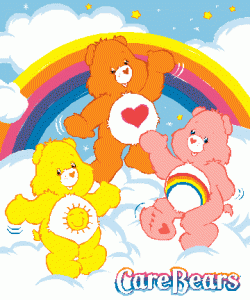Care Bears Birthday
I watched an episode of the 1985 Care Bears season. When the opening song came on, I immediately saw signs of Cross’ argument that the Program Length Commericals created a separate world for children not related to the realistic one that they would grow up in. During the opening song, one Care Bear sings “I don’t want to be a cook or a fireman, I don’t want to play trombone in the marching band, I just want to be a Care Bear like you!”. This shows that the children were being told not to have ideas of growing up to be something realistic, like a fireman, but instead being told to wish to “be a Care Bear”. During the episode however, the Care Bears visit a real boy who is upset that his parents are neglecting him and not throwing him a birthday party because his baby sister is being born. He’s resentful and angry at his parents. His friend tries to convince him to make a mess of his house to “get back at his parents, and although he’s a little hesitant, he still does do it some. The episode is all about the Care Bears trying to teach the boys a lesson of caring and understanding. The Care Bear’s attempt does reference the real world, as it tries to teach its viewers a moral of the story lesson. In the end, like all happily ever afters, the two boys learn to “care” because of their lesson, and they are happy about seeing the little baby sister. The birthday boy says he understands why his parents couldn’t throw him a party, and he still loves his new little sister. This episode does contradict Cross’ argument, as the Care Bears are trying to actually teach kids a lesson, as opposed to giving a thirty minute, unrealistic commercial of their toy.





